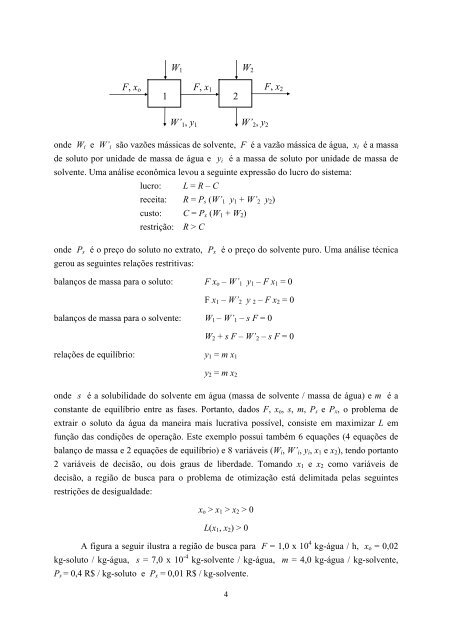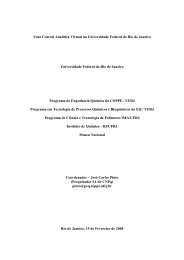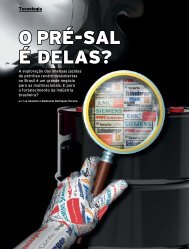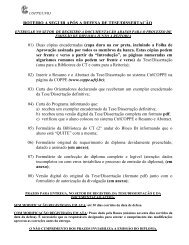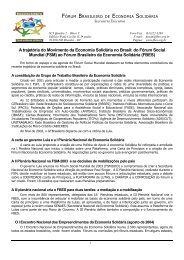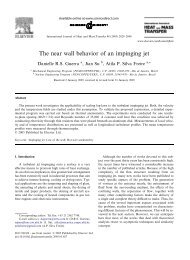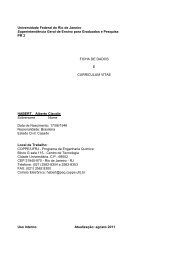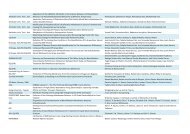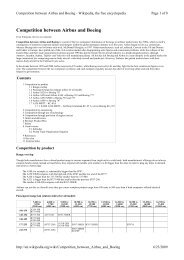CapÃtulo 10 - Programa de Engenharia QuÃmica - COPPE / UFRJ
CapÃtulo 10 - Programa de Engenharia QuÃmica - COPPE / UFRJ
CapÃtulo 10 - Programa de Engenharia QuÃmica - COPPE / UFRJ
Create successful ePaper yourself
Turn your PDF publications into a flip-book with our unique Google optimized e-Paper software.
48 WARSCHAUER ET AL.Downloa<strong>de</strong>d by [University Library Utrecht] at 13:21 <strong>10</strong> February 2014support is important when implementing one-to-one laptop programs (Drayton, Falk, Stroud,Hobbs, & Hammerman, 20<strong>10</strong>; Rutledge, Duran, & Carroll-Miranda, 2007). In Massachusetts,for example, one program <strong>de</strong>ployed laptops to middle school stu<strong>de</strong>nts to use throughout theday (Bebell & Kay, 20<strong>10</strong>). Although teachers and stu<strong>de</strong>nts in this study <strong>de</strong>scribed how laptopstransformed their classrooms into stu<strong>de</strong>nt-centered, collaborative environments, teachers’ use oflaptops varied wi<strong>de</strong>ly. Bebell and Kay (20<strong>10</strong>, p. 48) suggest that “it is impossible to overstatethe power of individual teachers in the success or failure of 1:1 computing” given the amount ofteacher training, investment in curriculum <strong>de</strong>velopment, and creation of new assessment methodsrequired when laptops are introduced. The financial bur<strong>de</strong>n of not only <strong>de</strong>ploying laptops, but alsoimplementing new assessments and teacher <strong>de</strong>velopment is a consi<strong>de</strong>ration when implementingthese programs in schools. These investments may particularly challenge low-SES schools,which usually face more severe budgetary constraints in providing these ongoing supports.These constraints can lead to inequitable implementation of technology programs (Becker, 2000;Warschauer, Knobel, & Stone, 2004; Wenglinsky, 2005).Laptop programs also may increase differences within schools between high- and lowachievingstu<strong>de</strong>nts. A study evaluating the Texas Technology Immersion Project, a one-tooneprogram in middle schools, suggested that test score gains were primarily seen in alreadyhigh-achieving stu<strong>de</strong>nts (Shapley, Sheehan, Sturges, Caranikas-Walker, Huntsberger, &Maloney, 2007); a subsequent study of this program found that the <strong>de</strong>vices, teachers’ professional<strong>de</strong>velopment, online curriculum resources, and online stu<strong>de</strong>nt assessments variedacross schools and teachers (Shapley, Sheehan, Maloney, & Caranikas-Walker, 20<strong>10</strong>). Theseresults suggest that laptop programs may increase disparities between high- and low-performingstu<strong>de</strong>nts.Two of the three districts discussed in this article implemented what might be called anintegrative approach, in which provision of hardware and software is balanced with broa<strong>de</strong>rforms of infrastructural and social support, including wireless Internet access, technical support,teacher training, and curricular reform (see Warschauer, 2011). The third district we studied waspart of the One Laptop per Child (OLPC) program, which emphasizes the transformative potentialof children’s ownership and autonomous use of its proprietary laptops and, thus, <strong>de</strong>-emphasizesfunding of teacher training, technology infrastructure, technical support, or curricular reform (seeOne Laptop per Child, n.d.; Warschauer & Ames, 20<strong>10</strong>).Comparing case studies from two school districts (Saugus and Littleton) following the integrativeapproach and one district (Birmingham) following the OLPC approach, this study examinesdifferences across multiple levels of implementation: mo<strong>de</strong>ls, districts, and case classrooms.METHODSResearch SitesThe three public school districts in this study—Birmingham, Littleton, and Saugus—share characteristicsthat make them suitable for comparison: each implemented a one-to-one programin upper elementary classrooms with inexpensive netbooks and open source software. Despitethese similarities, the districts vary in their <strong>de</strong>mographics, implementation mo<strong>de</strong>l, and stu<strong>de</strong>ntoutcomes.


